Tropics are the regions of Earth surrounding the Equator that are rich in all types of vivid-looking birds.
And a study from 2022 examining bird colors confirmed that tropical birds are about 30% more colorful than their temperate relatives!
After examining over 24,000 photos of 4,500 bird species, scientists concluded that male and female tropical birds found in forests of Australia, Ecuador, Chile, Indonesia, New Zealand, and Brazil, among others, have more stunning colors – as measured by the plumage reflectance – than those in the Northern Hemisphere.
According to their research, the most colorful tropical birds are found in dense and humid forests in the Amazon, West Africa, and Southeast Asia.
Examples of colorful tropical birds include the paradise tanager, scarlet macaw, resplendent quetzal, double-eyed fig parrot, blue and yellow macaw, and many others.
Here’s what each of these looks like.
Table of Contents
Colorful Tropical Birds
1. Paradise Tanager

- Scientific Name: Tangara chilensis
- Found In: South America
Paradise tanagers are brilliantly colored songbirds with light green heads, sky blue underparts, and black upper plumage. Males and females look alike but the males tend to sing more often. They also have black beaks and gray legs.
These multicolored songbirds are native to the Amazon rainforest of northern South America. Despite what their scientific name says, they are not found in Chile and can be seen in Brazil, Bolivia, Ecuador, Colombia, Peru, and Venezuela.
Paradise tanagers can be often seen high in the canopy of the humid forest, often in flocks of mixed species. They are omnivorous and feed on a range of fruits, nectar, berries, and insects.
Read More: More examples of incredible birds that have green heads
2. Wilson’s Bird Of Paradise
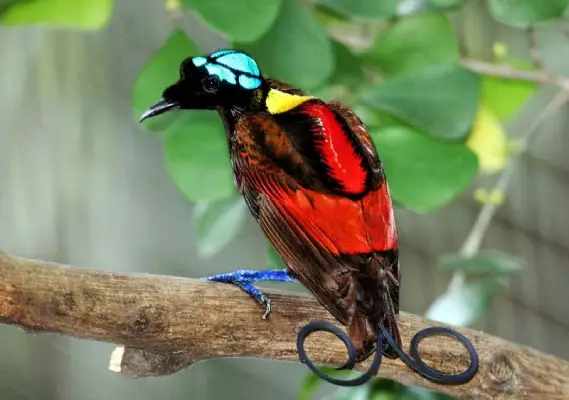
- Scientific Name: Cicinnurus respublica
- Found In: Asia
Wilson’s bird-of-paradise has David Attenborough to thank for its first television appearance, as he was the first to film them for the BBC’s documentary Attenborough in Paradise.
This unique and colorful tropical bird is native to Indonesia where it inhabits lowland rainforests on Waigeo and Batanta islands.
Male Wilson’s bird-of-paradise is black with red wings, a yellow neck mantle, and a blue head with a cross pattern. They also have two curved tail feathers. Females are more brownish.
They can be also identified in nature by a series of loud, down-slurred “piuu” calls. These black birds with red wings are listed as Near Threatened by the IUCN due to increasing habitat loss.
Wilson’s bird-of-paradise is an omnivore that feeds on insects, spiders, small invertebrates, and fruits. The specie was named by a French ornithologist Charles Lucien Bonaparte, who was Napoleon’s nephew.
3. Blue-naped Chlorophonia

- Scientific Name: Chlorophonia cyanea
- Found In: South America
Blue-naped chlorophonias are small, plump birds with stout beaks that live in humid tropical forests, gardens, and parks of South America.
Males are mainly lime green with blue napes, rumps, and eye-rings. Some populations can be entirely blue above; their underparts are yellow. Females are duller and have greener bellies.
Blue-naped chlorophonias can be often seen in small flocks or pairs and heard by their whistles that consist of one to two notes. They mostly forage in the canopy and feed on berries, leaves, nectar, and insect larvae.
Their breathtaking bright blue and green coloration provides them with great camouflage in the tree canopy.
4. Blue-throated Barbet
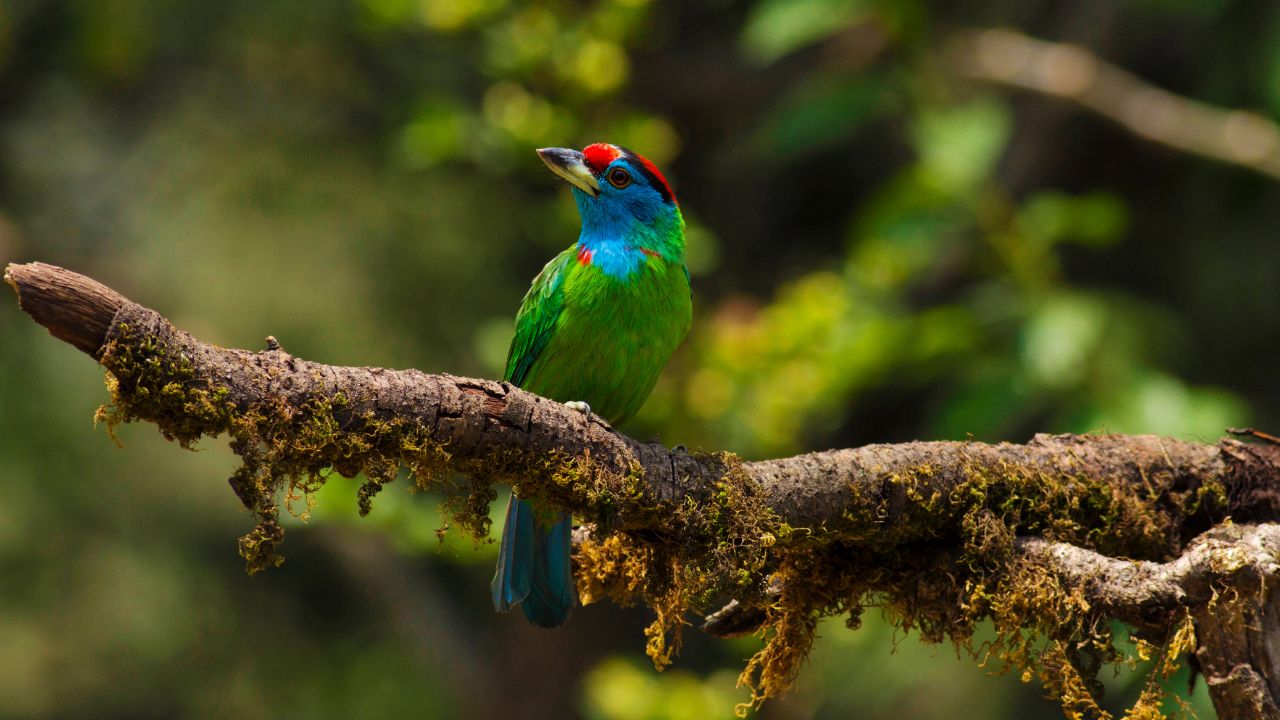
- Scientific Name: Psilopogon asiaticus
- Found In: Asia
Blue-throated barbets are medium-sized barbets that are native to Asia. They inhabit lowland and foothill tropical forests, at elevations ranging from 660 to 6,560 ft.
Blue-throated barbets are bright green with blue throats and faces. They were named after the bristles which fringe their heavy beaks.
Blue-throated barbets are omnivores and feed on insects and fruits. They usually forage in the forest canopy but might also visit lower shrubs to feed.
5. Asian Green Bee-eater

- Scientific Name: Merops orientalis
- Found In: Africa and Asia
Also known as little green bee-eaters, Asian green bee-eaters are small slender birds commonly found in Asia and Africa. They have bright green plumage with blue parts on the chins and throats, slender black face masks, and black throat bands. Their eyes are crimson, their beaks are black, and their legs are dark gray.
Asian green bee-eaters are common around open woodlands, fields, farmlands, and human habitats. These tropical species can be often seen flying gracefully and catching insects and other prey.
Asian green bee-eaters got named after their favorite type of food – bees. They can be often seen in small groups and roost in large numbers, often exceeding 200 birds.
Want to see more examples of charming green and yellow birds? Check this article.
6. Scarlet Macaw
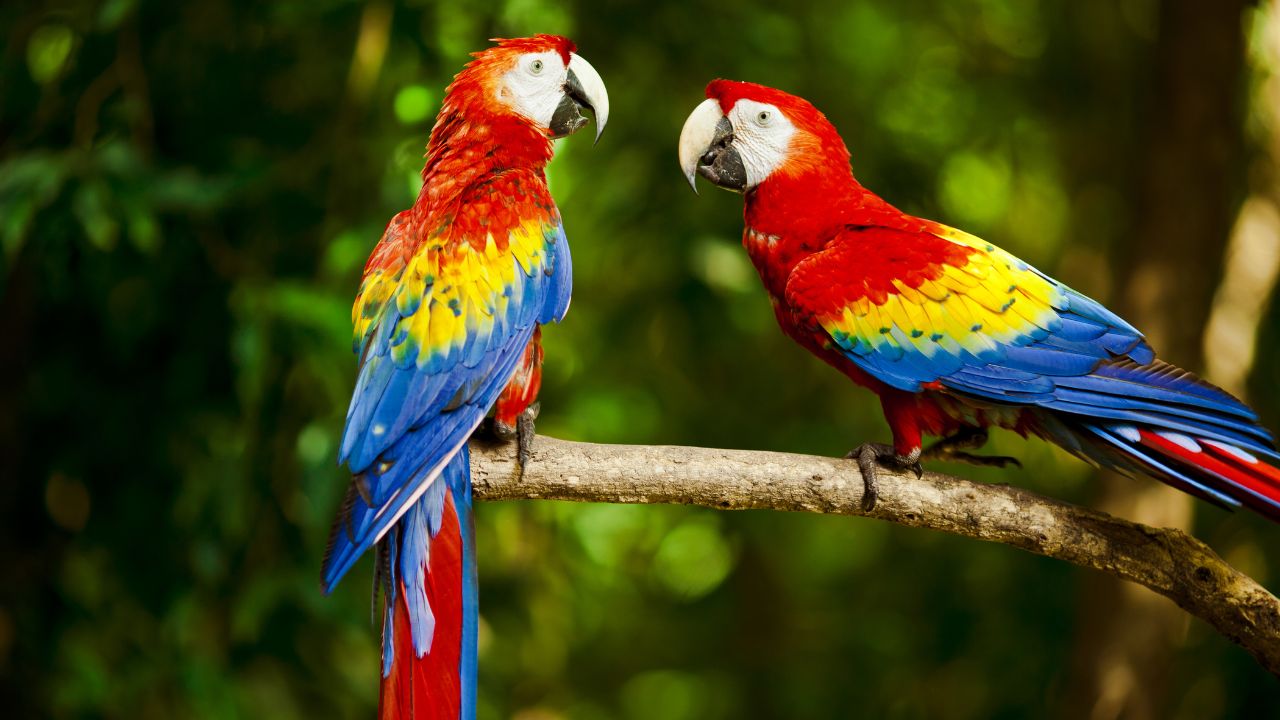
- Scientific Name: Ara macao
- Found In: Central and South America
Scarlet macaws are one of the biggest red parrots in the world. They span around 3.3 ft across the wings, measure 2.75 ft in length, and weigh around 2.3 lbs.
Scarlet macaws are mostly bright red with blue rumps and tail-covert feathers, dark blue wings, and yellow upper wing coverts. They also have white skin around their eyes and pale horn-and-black beaks.
Scarlet macaws are the national birds of Honduras and they breed in lowland rainforests and semiopen areas with big trees in Central and Southern America. They can be seen in countries like Mexico, Bolivia, Peru, Ecuador, Colombia, Brazil, and Venezuela.
Their striking colors make these tropical birds one of the most popular in aviculture. These parrots can live a long life, typically from 40 to 50 years; some manage to survive for 90 years!
During their breeding period, they become extremely aggressive. Scarlet macaws are monogamous birds that stay together for life and feed on fruits, nuts, seeds, flowers, fruit nectar, insects, and larvae.
These very intelligent birds can mimic human speech and will often make loud throaty squawks, squeaks, and screams to communicate with their group in the wild.
7. Red-cheeked Cordon-bleu

- Scientific Name: Uraeginthus bengalus
- Found In: Africa
Red-cheeked cordon-bleu or red-cheeked cordonbleu is a small finch that breeds in dry regions of tropical Sub-Saharan Africa. It is named after the dark red patches on the male’s cheeks.
Male red-cheeked cordon bleu can be identified by its striking brown upperparts, blue breasts, flanks, and tails, and red cheek patches. The female looks similar but has duller colors and lacks cheek spots.
Commonly found in pairs or small flocks, these birds are granivores that mainly feed on grass seeds, other small seeds, and some beeswax. There are four subspecies of red-cheeked cordon bleu, depending on the blue color on the face and female underpart color.
You can also try to identify them by their thin, high-pitched piping call that sounds like “siii siii” or “tsee tsee.” Their song consists of 4-6 high-pitched notes that sound like “wit-sit-diddley-diddley-ee-ee.”
Their eye-catching colors make them among the most popular exotic finches in aviculture.
8. Resplendent Quetzal
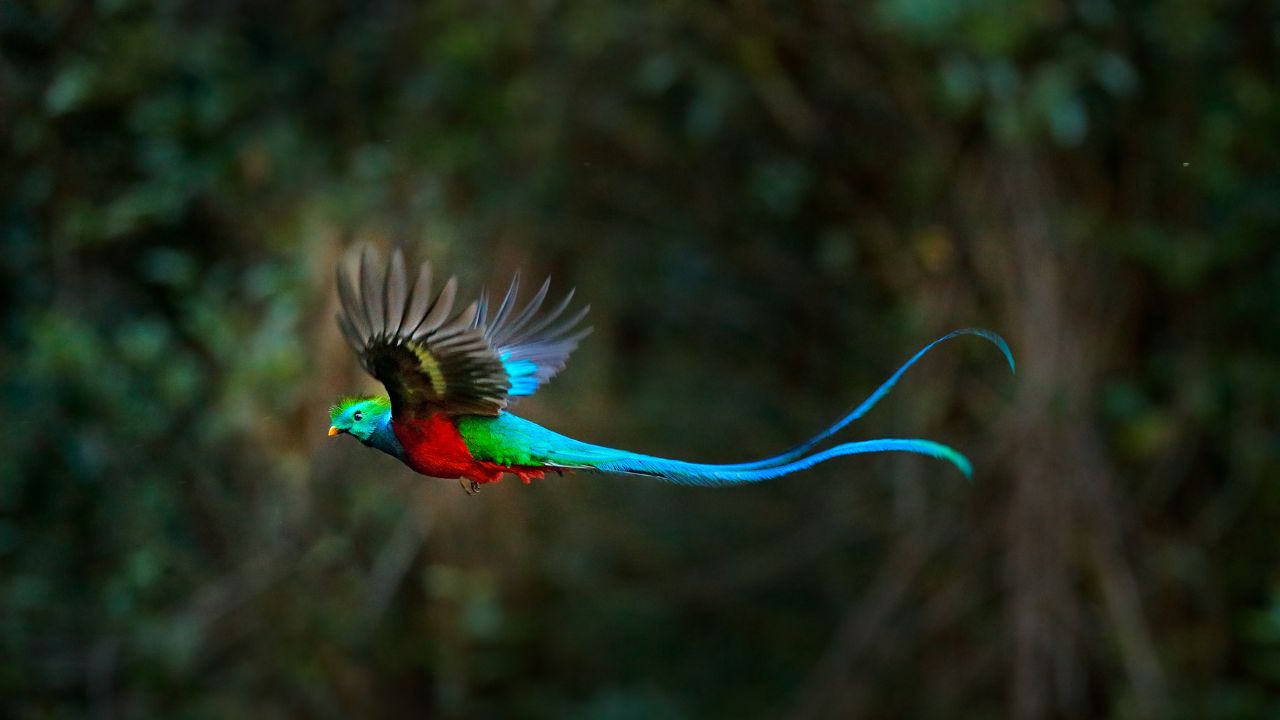
- Scientific Name: Pharomachrus mocinno
- Found In: Mexico and Central America
Resplendent quetzals are small tropical birds found in southern Mexico and Central America.
The name “resplendent” perfectly suits these vibrantly colored birds – the word means “attractive and impressive through being richly colorful or sumptuous”. Quetzal means sacred, erected, or precious.
Talking about their appearance, resplendent quetzals have iridescent metallic green-blue plumage, shaggy crests on their head, and red breasts and bellies. The long wispy tail feathers extend twice the length of the bird.
These beautiful birds live in the mountainous, tropical forests of Central America where they feed on fruit, insects, lizards, and other small creatures. Resplendent quetzals are territorial and monogamous birds but will spend time alone during the non-breeding season.
Resplendent quetzals are the national birds of Guatemala and Aztecs and Mayas valued them so much that they used their feathers as currency.
9. Rufous-bellied Niltava
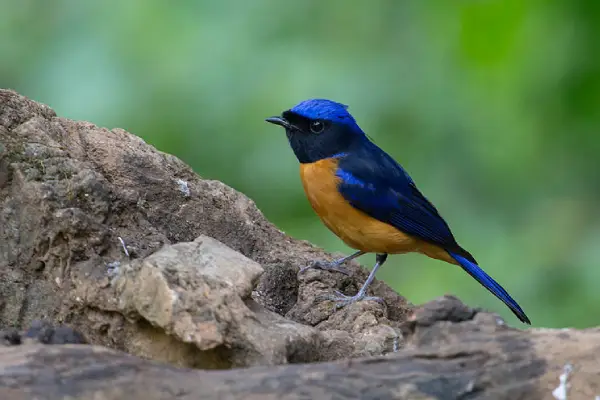
- Scientific Name: Niltava sundara
- Found In: Asia
Rufous-bellied niltavas are of the six species of niltava found in China. These large, stocky, and brightly colored flycatchers are bright blue and have orange bellies.
They measure around 6.5 inches in length and weigh only 0.8 oz. They have rounded heads, short tails, and broad beaks.
Rufous-bellied niltavas are common in subtropical or tropical moist lowland forests and subtropical or tropical moist montane forests. These birds are omnivores and feed on insects, larvae, and some fruits. They tend to spend their time solitary or in pairs.
Part of their scientific name “sundara” is a Latinised version of the Hindi word “sundar,” which means “beautiful”.
10. Superb Starling

- Scientific Name: Lamprotornis superbus
- Found In: Africa
Commonly found in East Africa, superb starlings are small birds with black heads, iridescent blue backs, upper breasts, wings, and tails. They also have dark orange bellies with a white bar.
Superb starlings are commonly found in subtropical and tropical forests, savannas, gardens, and cultivated fields, at elevations ranging from sea level up to 8,700 ft. Their long and loud song consists of trills and chatters and their harsh calls can be described as screeching “skreee-cheroo-tchereet.”
These brightly-colored and very gregarious birds are excellent fliers whose wing shapes help them move swiftly, maneuver quickly, and escape predators with ease. They are omnivores that mainly consume insects, berries, fruits, and seeds.
11. Double-eyed Fig Parrot
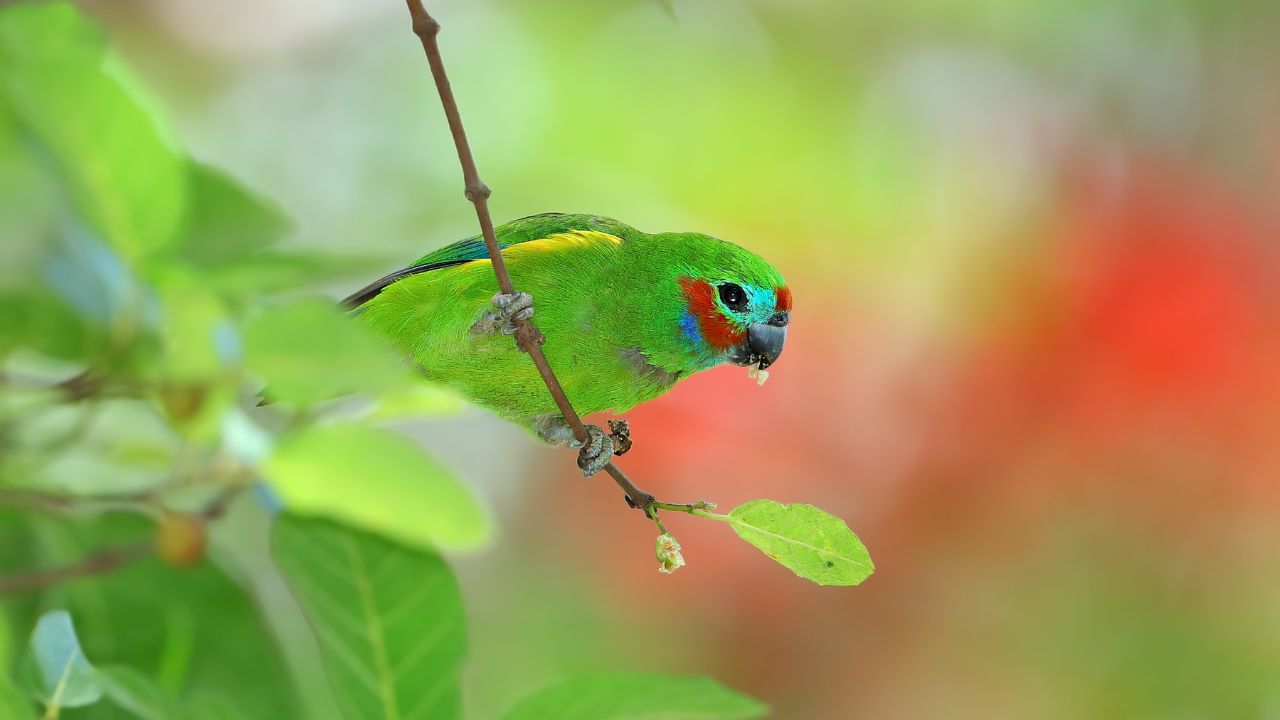
- Scientific Name: Cyclopsitta diophthalma
- Found In: New Guinea and Australia
Double-eyed fig parrots, also known as blue-faced fig parrots, are tiny rainforest-dwelling parrots found in New Guinea and Australia.
With a length of just 5.5 inches and a wingspan of around 10 inches, they are the smallest parrots in Australia. Double-eyed fig parrots are sexually dimorphic species; males are overall green with blue and red colors on their faces. Females have more subdued facial coloring and silver instead of red color on the cheeks.
They were named “fig-parrots” because they feed on fig seeds and “double-eyed” because of red patches that resemble another set of eyes. Double-eyed fig parrots also consume berries, seeds, nectar, and some insect larvae, feeding, alone or in small groups.
Unlike other parrots that are mainly cavity nesters, double-eyed parrots will excavate their nests, usually in a rotten tree.
12. Indian Roller
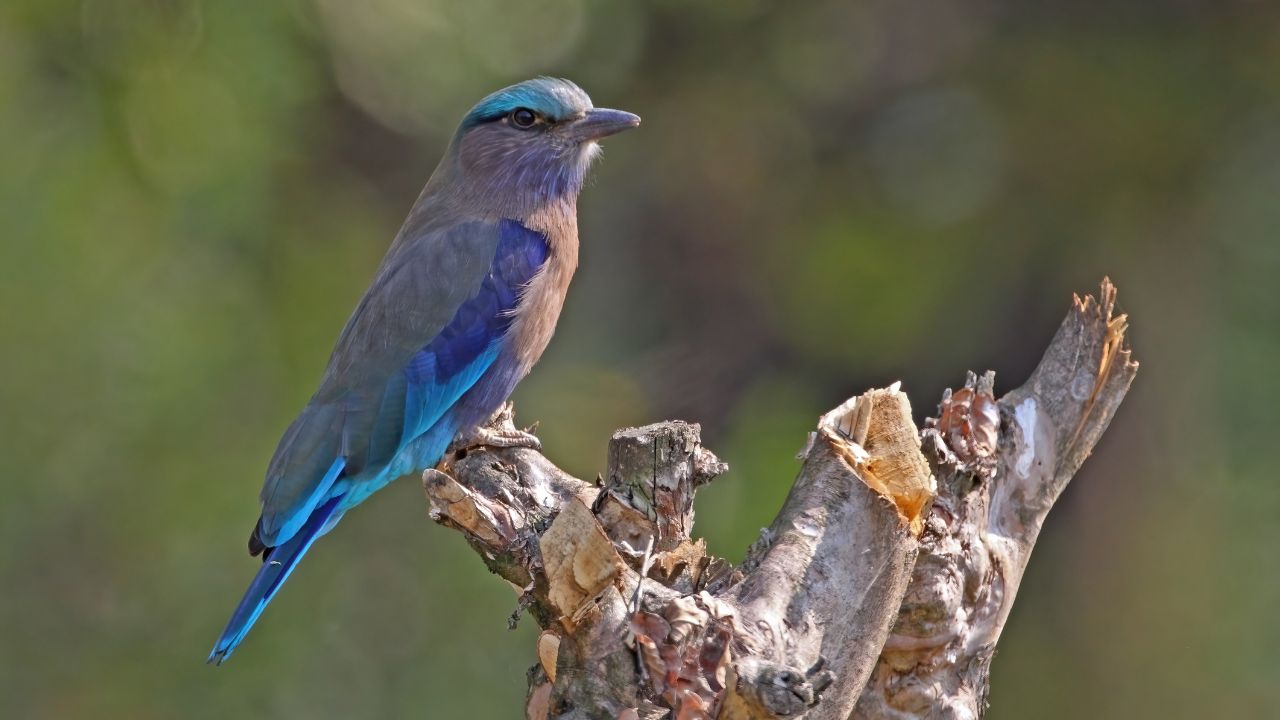
- Scientific Name: Coracias benghalensis
- Found In: Asia
This brightly colored bird has various shades of blue on its wings, tail, and belly. Indian roller has adapted well to human-modified landscapes and can be often seen sitting perched on roadside trees and wires.
The species is famous for their bright sky-blue wings and the aerobatic displays males perform during the breeding season. They will make steep, undulating flights, somersaults, nose-dives, hovering, and lateral rollings – that’s how the species got the name.
Often territorial, Indian rollers will patrol their areas by flying treetop high. When they spot an intruder, they will drive it away by a fast-rolling flight.
These birds are not particularly social and prefer to stay alone or in pairs. Indian rollers are monogamous and mate for life. They are the state birds of several Indian states, including Odisha, Karnataka, and Telangana.
13. Blue and Yellow Macaw
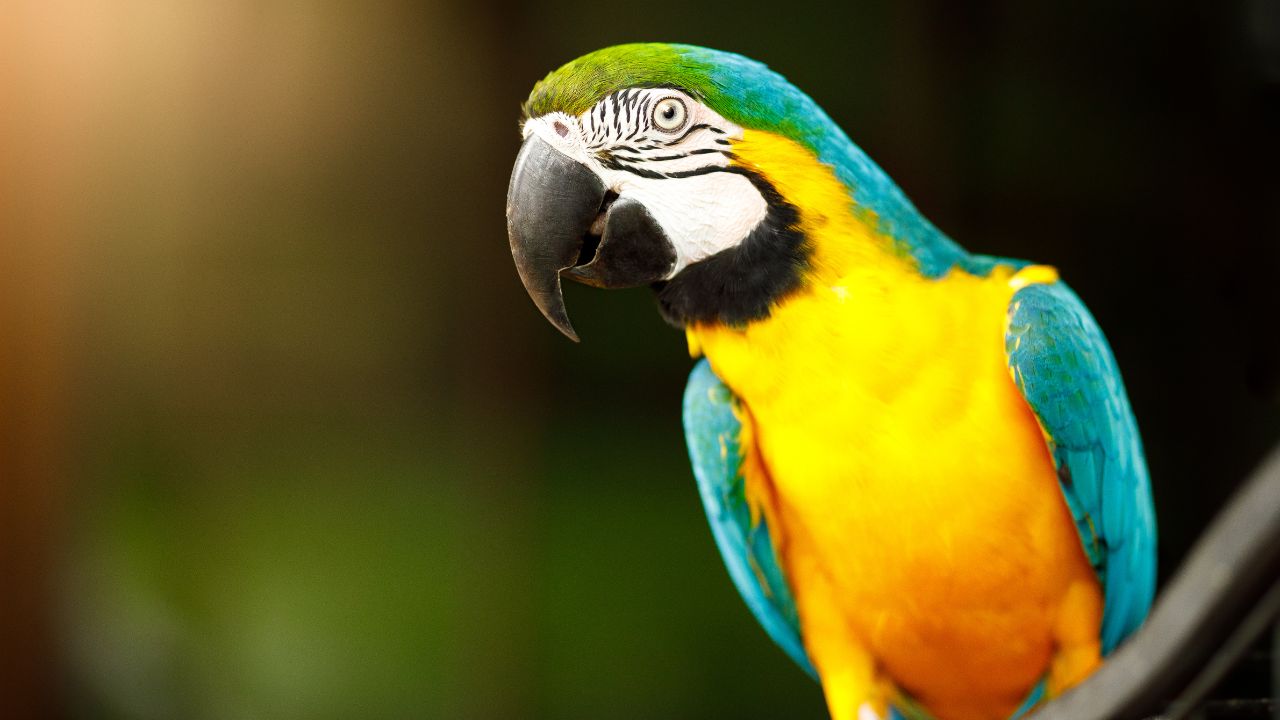
- Scientific Name: Ara ararauna
- Found In: South America
Blue-and-yellow macaws are large and colorful birds that are also known as blue-and-gold macaws. Their habitats include forests, woodlands, and savannahs of tropical South America, mainly Colombia, Venezuela, Peru, Brazil, Bolivia, Ecuador, and Paraguay.
Blue and yellow macaws are hard to miss with their gorgeous turquoise-blue bodies, green foreheads, and dark lemon-yellow chests. Their feet are gray, their beaks are black, and their eyes are pale yellow.
Striking colors, impressive size, ability to talk, availability in the marketplace, and close relationships with humans, make these macaws a popular pet choice. In case you decide to get one, remember that these parrots can have a long life, up to 70 years and more.
Macaws are monogamous and remain together for life. While flying, pairs will stay close together with their wings nearly touching. Blue and yellow macaws love to eat seeds in the wild – they drop a lot of them on the forest ground which promotes forest growth.
14. Javan Green Magpie

- Scientific Name: Cissa thalassina
- Found In: Asia
These brightly colored songbirds are one of Indonesia’s most beautiful green birds. They are also the most endangered, with a population of less than 50 mature individuals in existence today.
Javan green magpies, as the name suggests, are native to tropical forests on the Indonesian island of Java. Although born blue, these birds will turn apple green after their first molting due to a pigment in their diet called lutein.
Studies have shown that the vibrant, green feathers of the Javan magpie are important for attracting a mate for successful breeding. Also, during the mating display, they will raise their black masks.
They are carnivores that feed on insects, small lizards, and frogs. Due to habitat loss and illegal capture, they are now listed as Critically Endangered by the International Union for Conservation of Nature (IUCN).
15. Greater Bird-of-paradise
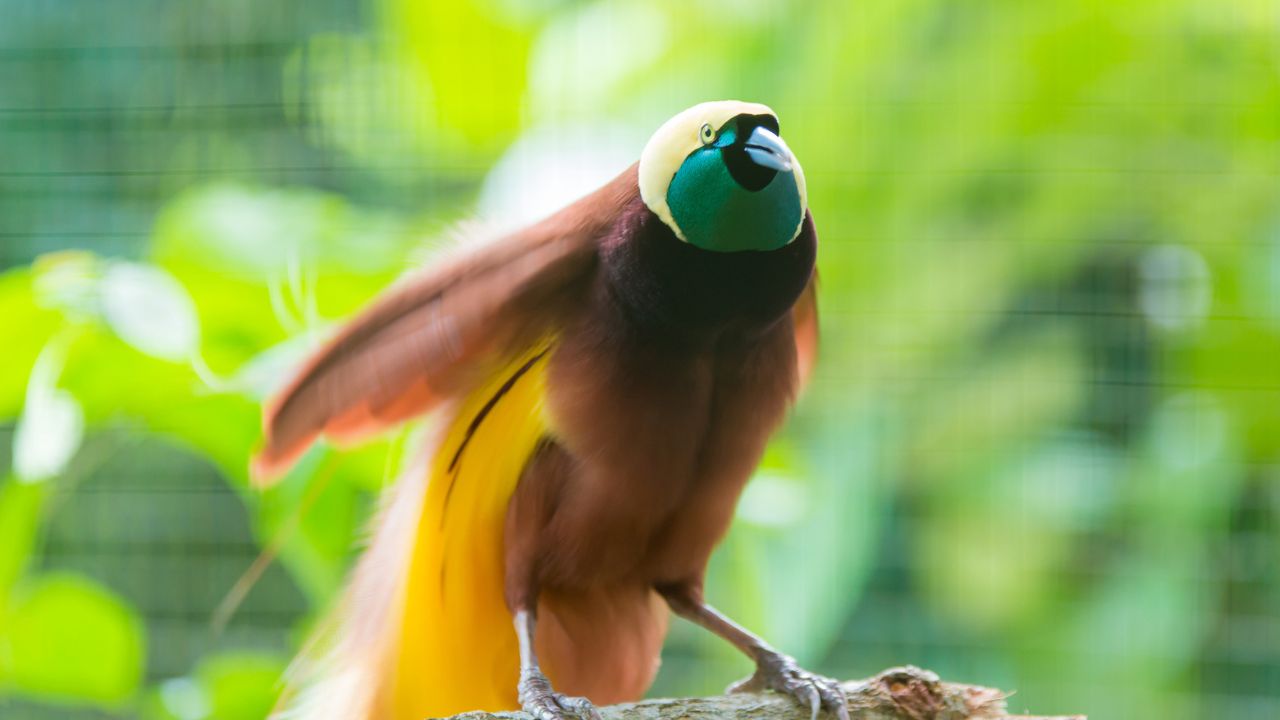
- Scientific Name: Paradisaea apoda
- Found In: New Guinea
The greater bird-of-paradise, found in southwest New Guinea and the Aru Islands in Indonesia, is a large bird of lowland and foothill forest and edge.
Males have black breasts and white and vivid yellow tail plumes which they raise above their back during display. This species is sexually dimorphic and the females are larger than the males.
These bright colorful tropical birds can be found on Trinidad and Tobago’s $100 bill. Males are polygynous and do not contribute to offspring raising in any way. Greater birds-of-paradise are omnivores that feed on fruit, seeds, and small insects.
Summary
Tropical regions are home to the most colorful bird species in the world. Even Charles Darwin talked about the “rich variety of colors” found in the tropics.
There are several possible reasons why tropical birds develop such vivid colors:
- they needed brightly-colored plumage to communicate in the dark tropical forests
- they got the color from their diet (from the color-forming compounds like carotenoids).
We hope you enjoyed these pictures of colorful tropical birds.